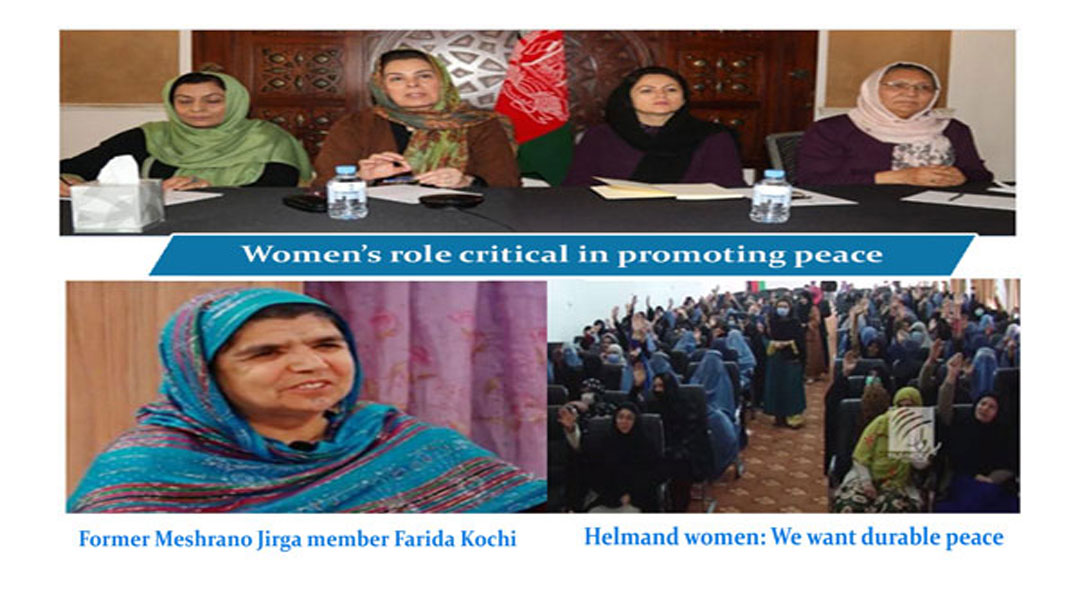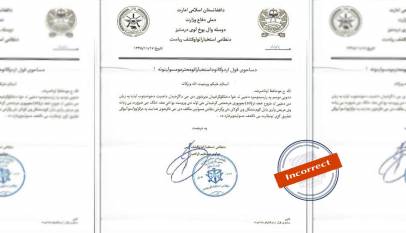Women’s role critical in promoting peace
KABUL (Pajhwok): The role of Afghan women in the peace process — unlike its media portrayal — is neither inadequate nor ceremonial.
The tradition of stretching or holding one’s scarf corner is still alive and some women, sticking to this custom, are determined to bring peace to their country.
A peace agreement was signed between the US and Taliban in Doha on February 29. Under the pact, 5,000 Taliban prisoners and 1,000 government inmates have been released.
Last week, an agreement between the Afghan government and Taliban negotiating teams was reached on ‘procedural rules’ for .the peace talks in Doha.
Radio Azadi, Hasht-i-Subh newspaper, Jamhoor Agency and various other media outlets, reporting on the role of women in the peace process, have characterised it as inadequate –and symbolic at that.
But Pajhwok’s findings show that in Afghan society, a woman’s headscarf remains a symbol of respect, as it has been for generations.
Although the number of women on the peace council and Doha negotiating delegations is far less than men, females are more involved and have been playing an active part in efforts for peace in the country and at the community level.
Mediation thru stretching scarf
Afghan women have long played a key role in ending conflicts and hostilities in their homeland. Experts say Afghan women have resolved implacable hostilities through the old tradition of mediation — stretching their scarf corners in front of rival parties.
Habibullah Rafi, advisor to the Afghanistan Academy of Sciences, told Pajhwok Afghan News mediation by women was an ancient tradition.
He added throughout history, there had been disputes and bloodshed between tribes and groups. Many elderly women have mediated peace and an end to conflicts by spreading their scarves.
In the past, he recalled, mediation by women had a lot of value for both sides that respected their rights. The women stopped fighting before elderly men negotiated an end to disputes.
Tajwar Kakar, a peace activist, acknowledged the tradition of mediation by women was one of the best tactics to end animosity between rival parties.
She continued: “My grandmother used to tell us this story — Amir Abdul Rahman Khan was known as a Black Amir in Kandahar, as he was cruel to the people. She and some other women once urged the Black Amir to stop atrocities. He did so out of respect for women.”
New peace effort via scarf spreading

Over the last two years, there have been constructive women’s movements and efforts for peace in Kabul and other provinces of the country. Some women are now trying to initiate peace movements under the title of spreading the headscarf.
Farida Kochi, a former senator, has launched efforts to bring women on a new platform for peace and a ceasefire between the government and Taliban.
“I’m busy trying to create a neutral association of women. There are men but they have done nothing. We’ll stand up and ask the Taliban what they will put in our scarves. I will stand on one foot for a hundred days to have something in my scarf. They must put something in our scarves.
“Jihad is that women ask the warring parties for peace, For the Taliban, jihad is to accept calls for a ceasefire and give us a message of peace,” Kochi remarked.
She said members of the peace-building movement would also call on the government to avoid creating unhappiness.”
Kochi said she had talked to women in Kabul about it, and would travel to all provinces to bring together elderly women, who have lost their children to the conflict and took care of orphans at home, on one platform.
A number of women held similar views and voiced their willingness to take part in peace-building movements.
Tajwar Kakar said: “No one gives us a chance. Creating such a group is not a difficult task in the current situation. If there is an opportunity for such services, I’m ready to do my bit for peace.”
According to her, women’s efforts and rallies for peace within the country were also beneficial. But to her, it is better to form a group of neutral women to visit Doha and beg both sides for peace and a lasting ceasefire.
She said both sides — the government and Taliban — are Afghans. Familiar with their traditions, they will not let their mothers’ and sisters return with empty scarves, she hoped.
Mohammad Sharif Zadran, head of Academy of Sciences’ History Department, referring to the tradition of stretching one’s scarf, suggested neutral Afghan women should create a team and request the UN to facilitate their travel to Doha.
Shahla Farid, a political science lecturer at the Kabul University, supported the idea of forming a group of neutral women, with no affiliation to any political party. This group’s members stretching the corners of their scarves to both negotiating teams would have a positive impact on peace talks, she believed.
Women’s mediation of disputes between two rivals has a long history in Afghanistan. It is named paronai ghurawal (Stretching the scarf corner), according to Farid.
Nazifa Haqpal, a former Afghan diplomat, wrote in an article on the subject that a woman’s shawl was a symbol of honour — just like a man’s turban.
“I have traveled to many areas of the country for the UN mission; I saw women being asked to mediate when the parties engage in hostilities. Disputes, in which many people are killed or wounded, can be resolved with the mediation of women,” she felt.
She thought only women could ease tensions because a warring side fighting on the basis of beliefs could not reject advice from their mothers.
Taliban and government views
“Peace talks are ongoing. We hope the problem would be solved through negotiations,” said the spokesperson fo Taliban’s Qatar office, when reminded of women’s efforts to create a group that ‘stretch their scarf corners’ for mediating between the negotiating teams.
Presidential spokesman Sediq Sediqi also lent his support to the idea of creating a group of neutral women and dispatching them to Doha to stretch their scarves in front of the negotiators and plead with them for peace.
He asked the Taliban to respect the Afghan women’s voice for peace and ceasefire. “The government always supported ceasefire, because it is the demand of all the people but the Taliban did not accept this suggestion so far,” he said.
Women’s efforts more coherent

According to reports, many women in Kabul, Helmand, Nangarhar and other provinces of the country have organised rallies, gatherings and civil movements for peace and ceasefire in Afghanistan.
Some of the women said they would pardon the killers of their spouses and children if it could help bring peace to Afghanistan.
Lal Mohammad Safa, a resident of Helmand province, said he was one of the organisers of many women’s rallies for peace.
The voice of women for peace is more consistent than men’s. Women put in more determined efforts in this regard because they are not engaged in conflict. Instead they are affected by the hostilities, he said.
“It is women who are widowed and lose their loved ones. They attend the gatherings that support peace and ask the warring sides to stop violence,” he added.
Limited, but not symbolic
The High Council for National Reconciliation (HCNR)’s political committee and leadership council have a total of 46 members, including eight women.
The Taliban’s negotiating team for also include four women and 17 men. But currently, the peace talks are led by men.
Sharifa Zurmati, a member of Kabul’s negotiating team, said it would have been better if there were more women in the delegation.
But despite the limited number of women, their participation was not ceremonial, she said, insisting that the women membes’ role was poactive.

About women members of the negotiating team, she said: “They have enough confidence and can represent their sisters and brothers who are in the team with us equally work for women’s rights and peace talks.”
Frozan Daudzai, a peace activist, also opined more women should have been part of the negotiating teams. Even the existing number has raised their voice just likemen.
She said that women’s role was not symbolic in the team and they were actively defending the rights of the gender in peace talks.
No women in Taliban’s team
Zurmati said that if there were women in Taliban’s negotiating team, females in both teams would have been able to better communicate with each other.
“If there were women in Taliban’s team, we could have comfortably talked to them and the result would have been much better,” she added.
Sharif Zadran also supported the proposal for women’s inclusion in Taliban’s team in line with today’s political realities.
Gulalai Safi, a member of the Meshrano Jirga, said the absence of women from Taliban’s negotiating team showed the rebel movement had not discussed the issue yet, or it did not want females to be part of its delegation.
Taliban spokesman Mohammad Naeem, in response to a question about the inclusion of women in such teams had a long history in Islam,
“Prophet Muhammad (SAW) was advised by his wife Hazrat Um-i-Salma, not by strange women. Mujahideen are also advised by their spouses…”
sa/mds/mud
Ahmad sohaib
Hits: 6754
Letter regarding ban on roaming during night is fake
KABUL (Pajhwok): The Ministry of Defence (MoD) and an expert have rejected the letter rega…



